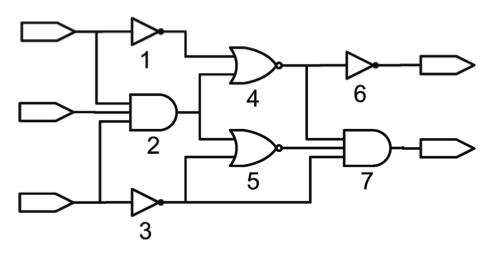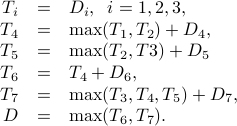Digital Circuit Design: Problem
Circuit topology
Design variables
Design objective
Circuit Topology
The combinational circuit consists of  connected gates, with primary inputs and outputs. We assume that there are no loops in the corresponding graph. For each gate, we can define the fan-in, or set of predecessors of the gate in the circuit graph, and the fan-out, which is its set of successors.
connected gates, with primary inputs and outputs. We assume that there are no loops in the corresponding graph. For each gate, we can define the fan-in, or set of predecessors of the gate in the circuit graph, and the fan-out, which is its set of successors.
Design Variables
The design variables in our models are the scale factors, which we denote by  ,
,  , which roughly determine the size of each gate. These scale factors satisfy
, which roughly determine the size of each gate. These scale factors satisfy  ,
,  , where
, where  corresponds to a minimum-sized gate, while a scale factor
corresponds to a minimum-sized gate, while a scale factor  corresponds to the case when all the devices in the gate have
corresponds to the case when all the devices in the gate have  times the widths of those in the minimum-sized gate.
times the widths of those in the minimum-sized gate.
The scale factors determine the size, and various electrical characteristics, such as resistance and conductance, of the gates. These relationship can be well approximated as follows:
The area of gate
 is proportional to the scale factor
is proportional to the scale factor  :
:  , with
, with  . (So, you can simply think of the scale factors as the areas.)
. (So, you can simply think of the scale factors as the areas.)The intrinsic capacitance of gate
 is of the form
is of the form

with  positive coefficients.
positive coefficients.
The load capacitance of gate
 is a linear function of the scale factors of the gates in the fan-out of gate
is a linear function of the scale factors of the gates in the fan-out of gate  :
:

where  are positive coefficients.
are positive coefficients.
Each gate has a resistance that is inversely proportional to the scale factor (the larger the gate, the more current can pass through it):

with  positive coefficients.
positive coefficients.
The gate delay is a measure of how fast the gate implements the logical operation it is supposed to perform; this delay can be approximated as

We observe that all the above parameters are actually posynomials in the (positive) design vector  .
.
Design Objective
A possible design objective is to minimize the total delay  for the circuit. We can express the total delay as
for the circuit. We can express the total delay as

where  represents the latest time at which the output of gate
represents the latest time at which the output of gate  can transition, assuming that the primary inputs signals transition at
can transition, assuming that the primary inputs signals transition at  . (That is,
. (That is,  is the maximum delay over all paths that start at primary input and end at gate
is the maximum delay over all paths that start at primary input and end at gate  .) We can express
.) We can express  via the recursion
via the recursion

The operations involved in the computation of  involve only addition and point-wise maximum. Since each
involve only addition and point-wise maximum. Since each  is a posynomial in
is a posynomial in  , we can express the total delay as a generalized posynomial in
, we can express the total delay as a generalized posynomial in  .
.
 |
Recursion for the total delay: For the circuit on the left, the total delay 
|
 , to primary outputs, labeled
, to primary outputs, labeled  . Each gate is represented by a symbol that specifies its type; for example, the gates labelled
. Each gate is represented by a symbol that specifies its type; for example, the gates labelled  and
and  are inverters. For this circuit, the fan-in and fan-out of gate
are inverters. For this circuit, the fan-in and fan-out of gate  is
is